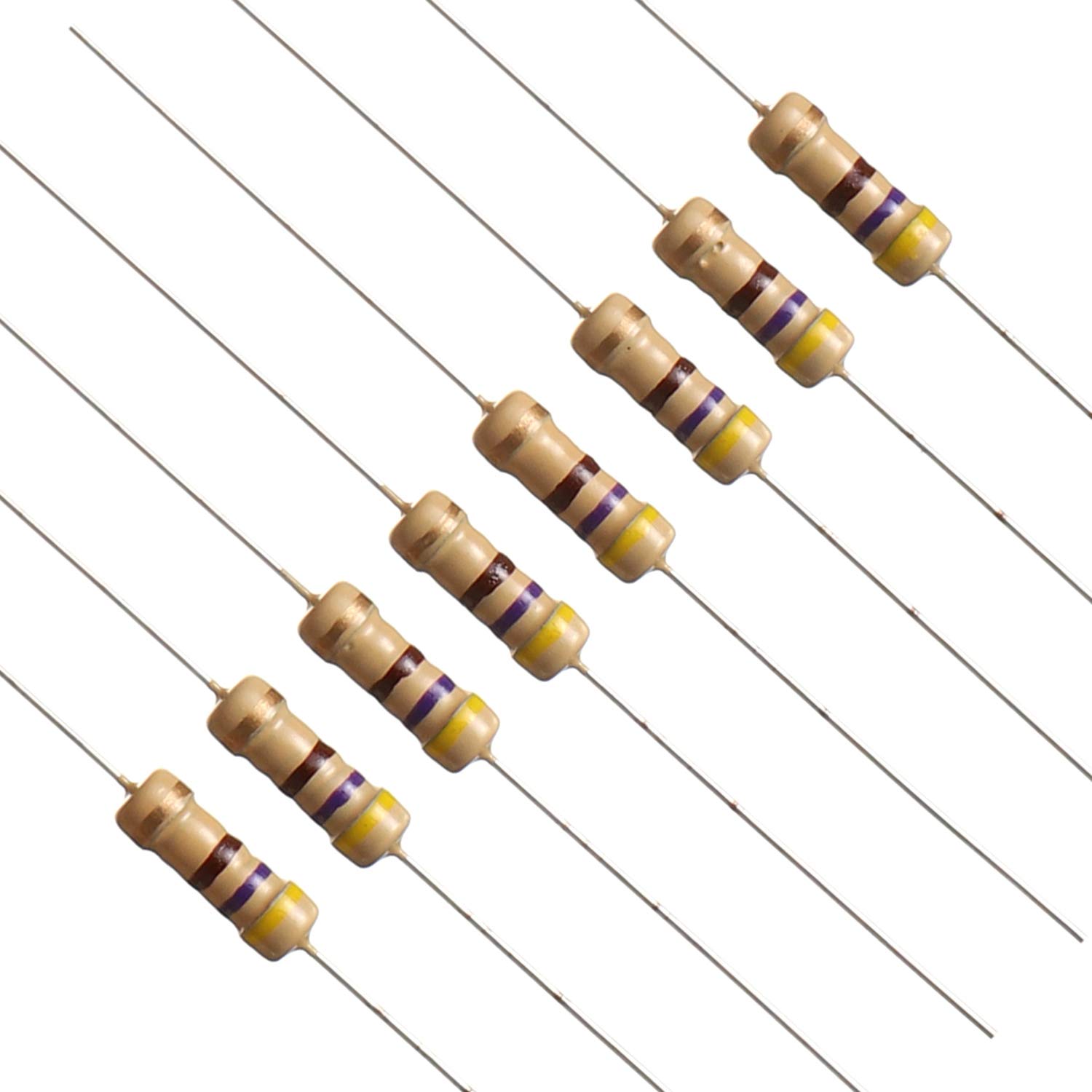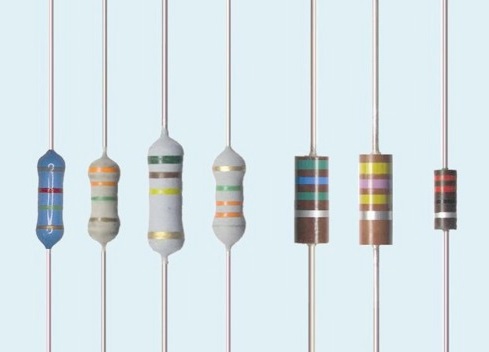Position:Home » Technical Articles
What are Metal Oxide Film Resistors?
Writer:Microhm Page View:Date:2019-09-25
Metal-oxide film resistors are fixed form, axial resistors. They are made of ceramic rod that is coated with a thin film of metal oxides, such as tin oxide. Metal oxide film resistors must not be confused with metal oxide varistors, made of zinc oxide or silicon carbide. Microhm Electronics NCA series is typical metal oxide resistor.
Metal oxide film resistors exceed the performance of metal film and carbon film for the following properties: power rating, voltage rating, overload capabilities, surges and high temperatures. Designers choose often the metal oxide film resistor for high endurance applications. Stability properties are less good than for the metal film resistor. The metal oxide film resistors have poor properties for low values and tolerance. The temperature coefficient is around 300 ppm/°C, which is higher than for metal film types.

The resistance material for metal oxide resistors is tin oxide that is contaminated with antimony oxide, this is to increase the resistivity. Metal oxide resistors can withstand higher temperatures than carbon or metal film resistors. The noise properties are similar to carbon resistors.
Many properties of metal oxide film resistors are similar to metal film resistors. For basic use, metal film and metal oxide film are currently the predominant resistor types. Compared to carbon film, the prices are just as low. Only for dissipation values above 1 watt combined with reasonable stability, the carbon film resistors are still more cost efficient.
The metal oxide film is mostly produced with chemical deposition methods. Almost always a ceramic carrier is used as substrate. The deposition process involves the reaction of a pure metal with a gas at high temperature and at a low pressure. A very common metal oxide film is tin oxide. The film is established by heating the resistor body in a tin chloride vapor. Other metal oxide films have usually a different deposition process. Firstly a thin metal film is applied, which is afterwards reacted with oxygen. The desired composition is achieved by measuring the resistance of a test piece.

After the film is applied to the resistor body, the final resistance value is achieved by applying a helical cut. This is usually done by laser cutting, while in the past it was done by grinding or sandblasting. The spiral cut makes the resistance path longer and of smaller cross section, and can increase the resistance value up to thousand times greater than before the cut. The resistance value can be accurately controlled by the cutting. During the cutting process, the resistance is measured to allow for small corrections.
Metal oxide film resistors were the first alternatives to carbon composition resistors. They were in the past easier to manufacture than metal film resistors. Nowadays however, their numbers decrease and they are less and less available.
Metal oxide film resistors exceed the performance of metal film and carbon film for the following properties: power rating, voltage rating, overload capabilities, surges and high temperatures. Designers choose often the metal oxide film resistor for high endurance applications. Stability properties are less good than for the metal film resistor. The metal oxide film resistors have poor properties for low values and tolerance. The temperature coefficient is around 300 ppm/°C, which is higher than for metal film types.

The resistance material for metal oxide resistors is tin oxide that is contaminated with antimony oxide, this is to increase the resistivity. Metal oxide resistors can withstand higher temperatures than carbon or metal film resistors. The noise properties are similar to carbon resistors.
Many properties of metal oxide film resistors are similar to metal film resistors. For basic use, metal film and metal oxide film are currently the predominant resistor types. Compared to carbon film, the prices are just as low. Only for dissipation values above 1 watt combined with reasonable stability, the carbon film resistors are still more cost efficient.
The metal oxide film is mostly produced with chemical deposition methods. Almost always a ceramic carrier is used as substrate. The deposition process involves the reaction of a pure metal with a gas at high temperature and at a low pressure. A very common metal oxide film is tin oxide. The film is established by heating the resistor body in a tin chloride vapor. Other metal oxide films have usually a different deposition process. Firstly a thin metal film is applied, which is afterwards reacted with oxygen. The desired composition is achieved by measuring the resistance of a test piece.

After the film is applied to the resistor body, the final resistance value is achieved by applying a helical cut. This is usually done by laser cutting, while in the past it was done by grinding or sandblasting. The spiral cut makes the resistance path longer and of smaller cross section, and can increase the resistance value up to thousand times greater than before the cut. The resistance value can be accurately controlled by the cutting. During the cutting process, the resistance is measured to allow for small corrections.
Metal oxide film resistors were the first alternatives to carbon composition resistors. They were in the past easier to manufacture than metal film resistors. Nowadays however, their numbers decrease and they are less and less available.
Keywords:
Latest News
- Resistor's role in measuring and correcting LED,,,
- Single through-hole resistors' characteristics ,,,
- Why shunt resistors for current sense applicati,,,
- Metal-film resistors with small size, high resi,,,
- 36W High-Current Shunt Resistors MMS8420,,,
- 1W Surface Mount Resistor MPR1206,,,
- An Overview of Microhm Electronics' Resistor Pr,,,
- More anti-sulfur resistors used in harsh envir,,,
- Resistance changes with temperature,,,
- 140W TO247 High Power Heatsinkable Resistor,,,
- MMS5930 is ideal for current sensing in industr,,,
- Shunt resistors selection for engineers' design,,,
- Considerations for choosing precision resistors,,,
- Ceramic Encased Cement Resistors NWH Series for,,,
- Resistors for Passive Balancing in Battery-Pow,,,
Hot Articles
- Microhm will take part in 10th Automotive World,,,
- Thanks for Visiting Microhm's Booth E5-5706 in ,,,
- Resistors in Short Supply: Blame Cars,,,
- New lunch: High Power Precision Shunt Resistor,,,,
- How to Test a Resistor,,,
- Innovative Technology, Future Electric: Electri,,,
- What is Precision Resistors?,,,
- SMD Resistors Sizes and Packages,,,
- The Construction and Features of Metal Film Res,,,
- What is a TO-220 Resisor?,,,
- Hot Selling Products: Precision Shunt Resistors,,,
- How to Calculate the Equivalent Resistance Valu,,,
- What is a Fixed Resistor?,,,
- Resistors in LED Circuits,,,
- Resistors Types and Materials Overview,,,
Resistance applications
- The Main Application for High Precision and Low,,,
- BMS for New Energy Vehicle,,,
- Industrial Roberts Applied to Solar Photovoltai,,,
- Carbon Film Resistors' Features and Application,,,
- Precision Resistors' Construction and TCR,,,
- Difference Between High Precision Resistors and,,,
- Urbanization Development Bringing the Transform,,,
- Select the Right Resistor for Harmonic Filterin,,,
- The Four Important Functions of Alloy Resistors,,,
- Why Zero-Ohm Resistors?,,,
- Shunt Resistor MMS8420 for High Current Stable ,,,
- Miniature future for passive electronic compone,,,
- Heater Blower Motor Resistor in Air Conditioner,,,
- Surface Mount Resistor's Size and Package ,,,
- The Measurement Accuracy of Automotive Shunt is,,,
